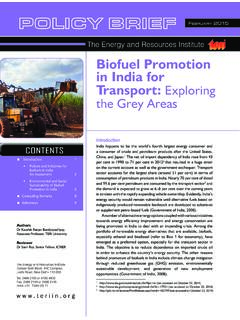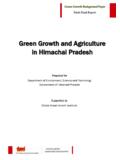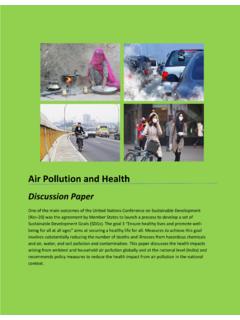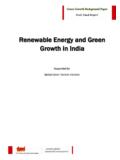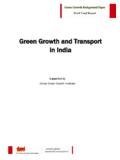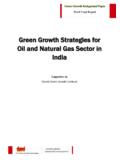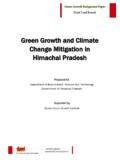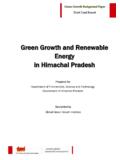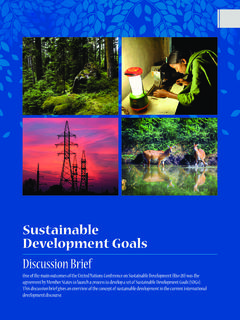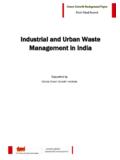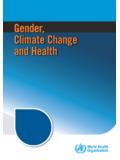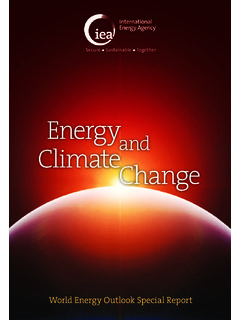Transcription of Green Growth and Sustainable Development in India
1 Green Growth and 1. Sustainable Development in India Towards the 2030 Development Agenda Summary for Policymakers The Energy and Resources institute Copyright November (2015). Global Green Growth institute 19F Jeongdong Building, 21-15, Jeongdong-gil, Jung-gu, Seoul, Korea 100-784. The Energy and Resources institute Darbari Seth Block, India Habitat Centre, Lodhi Road, New Delhi, Delhi 110003. Disclaimer The Global Green Growth institute does not make any warranty, either express or implied, or assumes any legal liability or responsibility for the accuracy, completeness, or any third party's use or the results of such use of any information, apparatus, product, or process disclosed of the information contained herein or represents that its use would not infringe privately owned rights.
2 The views and opinions of the authors expressed herein do not necessarily state or reflect those of the Global Green Growth institute . While every effort has been made to ensure the correctness of data/ information used in this report, neither the authors nor Institutes accept any legal liability for the accuracy or inferences drawn from the material contained therein or for any consequences arising from the use of this material. Steering Committee B. K. Chaturvedi, Former Member, Planning Commission; Former Cabinet Secretary, Government of India (Chair). R. K. Pachauri, Director-General, The Energy and Resources institute P. Mitra, Chief Secretary, Government of Himachal Pradesh Deepak Sanan, Additional Chief Secretary, Department of Environment, Science, and Technology Sarvesh Kaushal, Chief Secretary, Government of Punjab G Vajralingam, Principal Secretary, Department of Science, Technology, and Environment, Government of Punjab Per Bertilsson, Assistant Director-General, Global Green Growth institute Onno Ruhl, India Country Director, World Bank United Nations Resident Coordinator, India (Ex-Officio).
3 Naina Lal Kidwai , Country Head, HSBC India ; Director HSBC Asia Pacific R. V. Verma, Chairman and Managing Director, National Housing Bank Prabir Sengupta, Distinguished Fellow, TERI; Former Secretary, Ministry of Commerce and Industry Prodipto Ghosh, Distinguished Fellow; Former Secretary, Ministry of Environment and Forest Shri Prakash, Distinguished Fellow, TERI; Former Member, Ministry of Railways S. Vijay Kumar, Distinguished Fellow, TERI; Former Secretary, Ministry of Rural Development CONTENTS. Green Growth in Indian India 's Green Growth Green Growth Interventions and their Policy The Way ACKNOWLEDGEMENTS. This report is based on close collaboration between Global Green Growth institute (GGGI) and The Energy and Resources institute (TERI). A Steering Committee chaired by Mr.
4 BK Chaturvedi and composed of Dr. R. K. Pachauri, Mr. P. Mitra, Mr. Deepak Sanan, Mr. Sarvesh Kaushal, Dr. G Vajralingam, Mr. Per Bertilsson, Mr. Onno Ruhl, United Nations Resident Coordinator, Ms. Naina Lal Kidwai, Mr. R. V. Verma, Mr. Prabir Sengupta, Dr. Prodipto Ghosh, Mr. Shri Prakash and Mr. S. Vijay Kumar served as guiding team with supports of technical team. Mr. Siddarthan Balasubramania (Country Head, GGGI India ) and Dr. Suneel Pandey (Director, Green Growth and resource Efficiency, TERI) provided valuable oversight for the project. The contents were drafted by the technical teams of TERI and GGGI. Ms. Shailly Kedia, Mr. Anandajit Goswami and Ms. Rinki Jain contributed as lead authors from TERI; Dr. Prasoon Agarwal, Mr. Siddarthan Balasubramania and Mr. Ajith Radhakrishnan contributed as lead authors from GGGI.
5 ABOUT THE INITIATIVE. Green Growth AND Development IN India . Prelude The Ministry of Environment, Forest and Climate Change recognizes poverty eradication along with Green Growth ' as central to India 's Sustainable Development narrative. This vision also embodies the cogent definition of Green Growth by the Thirteenth Finance Commission of India as a narrative that enables rethinking Growth strategies with regard to their impact(s) on environmental sustainability and inclusiveness. The concept of Green Growth assumes centrality of socio-economic inclusivity to Sustainable Development in India . About the Project The project, Initiative on Green Growth and Development in India , aims to build evidence through which the Indian economy can move towards an inclusive Green Growth paradigm of Development .
6 The evaluation aims to combine the rigorous studies done at the national and state levels (Punjab and Himachal Pradesh). The collaborative research project implemented by The Energy and Resources institute with support from the Global Green Growth institute , uses an integrated systems modelling framework that robustly identified the opportunities for Green Growth in terms of; efficient use of natural resources, the adoption of new technologies, the minimization of environmental impacts, and the reduction of risks associated with natural hazards and commodity scarcities. A rich mix of quantitative analysis and stakeholder engagement was used to inform interventions and policy recommendations. The project has benefited richly from a very effective project management architecture that comprised of a national steering committee, supported by the project management committee.
7 At the state level, the team received strategic and technical inputs from the nodal departments; Department of Science, Technology, Environment and Non-conventional Energy, Government of Punjab along with the Punjab State Council for Science & Technology is the nodal agency of the project for Punjab while the Department of Environment, Science and Technology, Government of Himachal Pradesh is the nodal agency in Himachal Pradesh. Approach The study uses evidence-based analytical methods for developing policy choices and Green Growth opportunities. The analytical insights produced are validated against case studies from field visits, extensive government-stakeholder consultation and a comprehensive policy landscape analysis of sector-wise interventions in Himachal Pradesh and Punjab.
8 The illustration below indicates the suite of analytical tools deployed by the team. Outcomes In order to understand linkages between Development outcomes and Green interventions, two sets of models are considered. On one side, the energy supply and demand has been analysed through an energy system model TERI-MARKAL (MARKet Allocation MARKAL). On the economy side, a simulation based dynamic, recursive computable general equilibrium (CGE) model is used. The study has been able to generate, unique high resolution, actionable climate and spatial information for policy making in the two states. In addition to the model outputs (SWAT, PRECIS), the study has also looked at field based case studies for specific challenges faced by the state governments in Punjab and Himachal Pradesh. Green Growth AND.
9 Sustainable Development IN India . Green Growth in Indian Context India 's Eight-Point Intended The 2030 Sustainable Development Agenda with Nationally Determined Contribution 17 Sustainable Development goals and 169 targets To put forward and further propagate a healthy and that were adopted in September 2015 demonstrate Sustainable way of living based on traditions and values the scale and ambition of member states in the new of conservation and moderation. universal agenda. 1. To adopt a climate friendly and a cleaner path than the one followed hitherto by others at The Constitution of India contains specific provisions corresponding level of economic Development . for the protection and improvement of environmental 2. To reduce the emissions intensity of its GDP by quality. Article 48-A of the Constitution says that the 33 35 per cent by 2030 from 2005 level.
10 State shall endeavour to protect and improve the 3. To achieve about 40 per cent cumulative electric environment and to safeguard the forests and wild life power installed capacity from non- fossil fuel . of the country. Article 51-A (g) says that It shall be based energy resources by 2030 with the help of duty of every citizen of India to protect and improve transfer of technology and low cost international the natural environment including forests, lakes, finance including from Green Climate Fund (GCF). rivers and wild life and to have compassion for living 4. To create an additional carbon sink of 3 billion tonnes of CO2 equivalent through additional forest creatures. These provisions highlight the national and tree cover by 2030. conscience on the importance of environment 5.
